Do you know how to make your pet’s final days peaceful and dignified? Do you understand the needed care at the end of life for cats? It’s not an easy topic, especially if you are right in the middle of this final caregiving. That’s where I am at present with my Pogo cat, so have written this post as much to help myself as to help any others facing this sad situation.
Changes In The Older Cat
From age 11, you can begin to notice external indicators of aging. The cat’s sense of smell, taste, and hearing become less acute. They lose mobility because of worn-down joints. Skin and coat can become duller because the sebaceous glands which generate oils to nourish the skin become less productive. Arthritis makes grooming harder.
Dental problems such as worn teeth or gum diseases can affect appetite and make it painful for them to eat. Bad digestion and other bodily functions slow down, they may not absorb all the nutrients they need from food, and they may lose weight.
Cognitive impairment affects more than 80% of cats between the ages of 16 and 20. They may become unable to sleep soundly, and may forget their routine, such as the location of their food or litter box.
Make Your Cat As Comfortable As Possible
You can help ease these changes as your kitty approaches the end of life, with some small changes. Make their favorite places easy to reach by providing ramps or some steps. Surround these favorite spots with their favorite toys. Keep food and water in easy reach. Provide a litter box with low sides so it’s easy for them to enter and leave.
What Are Signs Your Cat Could Be Dying?
Many of these are also common symptoms of illness. These could include kidney disease, hyperthyroidism, cancer, and diabetes mellitus. Ask your vet to examine your cat and the vet can tell you whether these symptoms can be treated.
Watch for these signs:
1) Extreme Weight Loss
Senior cats often experience weight loss, though some of this comes from normal muscle loss. However, over time this weight loss can become extreme. The cat might become very thin, with ribs, spine, and hip bones protruding under the skin.
My Pogo has cancer. Cancer can cause cochexia, a particular form of extreme weight loss caused by cancer. The rapidly dividing cancer cells use so much of the cat’s energy that the body breaks down fat stores and muscle for fuel. Other diseases, such as hyperthyroidism or chronic kidney disease can also cause weight loss.
2) Hiding More Than Usual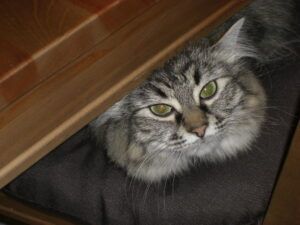
Watch for increased hiding, hiding in new places, or not wanting to come out even for routine positive events such as meals.
3) Not Eating
I have had to find creative ways to get Pogo to eat. I always warm his food. Since a cat sometimes loses some sense of taste and smell, he may be less interested in food. I learned a tip from this research source that helped encourage him to eat this morning. I added a small amount of tuna juice to the meal to make the odor stronger and provide more interest. It worked.
4) Not Drinking Water
If your cat does not drink, it could lead to dehydration. Add water to canned food, as this will help. You can use an oral syringe or squirt bottle to give him water, but do so carefully. Make sure the cat’s muzzle is pointed downward and squirt only a small amount into the mouth at a time.
If you force the cat to drink too much water at a time, the water can go down the trachea and into the lungs, causing choking or even aspiration pneumonia.
5) Lethargy
Near the end of life the cat will become less active. He may sleep more and may be weak when awake. Sometimes the cat will appear depressed and listless.
6) Decrease In Mobility
Such a change might result from muscle loss, pain from arthritis, or other challenges. This mobility loss can often progress from something small to larger changes.
Make sure your cat has ease of access to everything he needs. Provide ramps or steps to get kitty safely to his favorite perches.
7) Changes In Behavior
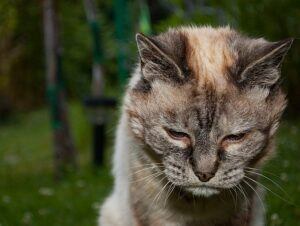 When a cat approaches death, he may exhibit a wide variety of changes. He may become more reclusive or may show crankiness or irritability. Other cats become more friendly and clingy.
When a cat approaches death, he may exhibit a wide variety of changes. He may become more reclusive or may show crankiness or irritability. Other cats become more friendly and clingy.
The cat may experience cognitive dysfunction, similar to human dementia. He may wander at night or become more vocal. He might also appear confused or get lost in a familiar environment.
The cat might disappear for periods of time, skip meals, or develop a different sleep pattern.
8) Not Responding Well To Treatments
Many diseases in senior cats respond to medications or other treatments. However, over time, the effectiveness of these measures can diminish and may require higher doses. This might indicate that kitty’s body is breaking down and he can no longer utilize medication normally.
9) Temperature Regulation Becomes Poor
Kitty can become increasingly more susceptible to heat or cold. Even in a warm setting, when the cat nears death, he often has a low body temperature. His limbs may feel cool to the touch.
1) Unkempt Appearance
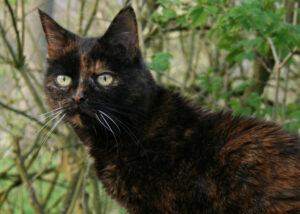 When a cat doesn’t feel well, he frequently stops grooming himself. The coat becomes greasy and scruffy-looking. He may exhibit excessive dandruff.
When a cat doesn’t feel well, he frequently stops grooming himself. The coat becomes greasy and scruffy-looking. He may exhibit excessive dandruff.
Pogo has not groomed for a couple of weeks. His beautiful, shiny coat now looks oily and matted. I have tried to help this situation by bathing him with a well-wrung-out washcloth that I’ve wet with warm water.
I wash his coat, working to remove matted tufts; then I rub him gently dry with a soft towel. Then I brush and comb him. He seems to appreciate it.
11) Abnormal Body Odor
Near the end of life, this sign might develop. Breakdown of tissues and buildup of body toxins may result. The odor might vary, depending on the disease.
12) Breathing Abnormally
Because muscles and nerves that control breathing, these may also break down with age. A dying cat may develop an abnormal breathing pattern, the respiratory rate speeding up and slowing down at random. The cat may even stop breathing for short periods of time.
Look for these signs to indicate breathing difficulty: open-mouth breathing, stretching the head and neck straight out from his body and strong abdominal movements. These symptoms occur when the cat struggles to get enough oxygen, and they constitute an emergency.
Dr. Alice Villalobos, a veterinary oncologist, has developed a quality-of-life scale for cats, which provides owners and vets a set of categories to help determine that the time has come. The list of categories include the following:
1) Hurt
Adequate pain control, which includes the ability to breathe properly, must be addressed. Cats hide pain extremely well. If breathing becomes a problem, the cat will become very still. An oral or injectable medicine may be necessary.
2) Hunger
If your cat cannot eat willingly or properly you can try hand feeding. If this solution will not work,

you may wish to consider a feeding tube for blended or liquid diets.
3) Hydration
If your kitty becomes dehydrated, you can ask the vet to inject fluid under the skin. It can really help an older cat feel better.
4) Hygiene
A cat likes to keep itself clean. Brush, comb, and do what you can to help him out. You might try a waterless shampoo.
5) Happiness
Keep a comfortable place for kitty near you so the cat remains a part of life’s activity. Cats communicate with their eyes and by purring. You will help the cat by making sure he still interacts with family members.
6) Mobility
If the cat cannot move around by itself, you could consider a mobility device. Cats accept such devices as two- or four-wheeled carts quite well, as long as their pain is managed. Work with your vet on these issues.
7) More Good Days Than Bad
When too many bad days occur in a row, or if the cat seems totally out of tune with the life around him, quality of life may be compromised. Bad days can include nausea, vomiting, diarrhea, seizures, frustration, continuous pain or discomfort, or inability to breathe.
You can use this quality-of-life scale to evaluate how well your cat’s basic needs are being met. It can also help you decide if euthanasia is the best choice for the cat.
Pet Hospice Care
Pet hospice care, or palliative care, has a goal of making a pet’s final days or weeks more pleasant through the use of proper pain meds, dietary strategies, and human interaction.
Pet hospice is not a place, but a personal choice and philosophy based on the premise that death is a part of life and can be dignified.
Through pet hospice, you become your pet’s primary nurse and caregiver, as well as the link between your and your vet.
What About Euthanasia?
This practice provides a painless, peaceful way to end your pet’s life, and will terminate his suffering.
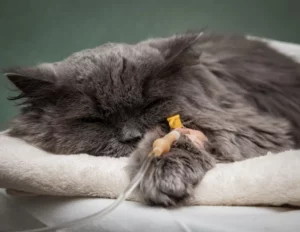 Your vet will inject your kitty with a sedative followed by a special medication. The animal will experience no awareness of the end of life. The process is similar to undergoing a general anesthesia for a surgery or procedure. It takes 10 to 20 seconds.
Your vet will inject your kitty with a sedative followed by a special medication. The animal will experience no awareness of the end of life. The process is similar to undergoing a general anesthesia for a surgery or procedure. It takes 10 to 20 seconds.
Your vet can help advise the best time to euthanize. When you see that the moments of discomfort outweigh his capacity to enjoy life, the time has come. If your kitty experiences pain, your main goal should be to minimize his suffering.
What Should You Do If The Pet Dies At Home?
You have options to consider here. Do you simply want the body removed from your home? Do you wish some other special way to memorialize him? The choice is yours.
You may have to keep the body in your home for a short time. Cool the body well and you can hold it for up to 24 hours. The sooner you move it the better.
Placing the wrapped animal in a refrigerator or a freezer is recommended. If the animal size will not allow such placement, lay it on a cement floor or concrete slab. Do not cover or wrap the body in this case, as it will trap heat and not allow the body to cool.
If necessary, you can keep the body in the coldest part of the house, out of the sun, and packed with bags of ice. Place the body in a plastic bag to prevent it from getting wet.
Depending on local laws, it may be legal to bury an animal on your own property. However, do not bury it on public lands.
Sometimes your local sanitation department will pick up animal remains.
Dealing With Pet Loss
Your grief may take many forms, and friends and family can provide a support group.
Your grieving becomes part of a natural process. Your pet represented an important part of your life and provided companionship and love.
Though no other pet can ever replace your cat, you can remember the special things he brought to your life and cherish the good memories.
The references I used for this post gave excellent information, and I encourage you to read them in their entirety. Here are the references I used:
royalcanin.com/us/cats/health-and-wellbeing/end-of-life-care-for-your-cat
dailypaws.com/living-with-pets/end-of-life-care/signs-a-cat-is-dying
vcahospitals.com/know-your-pet/quality-of-life-at-the-end-of-life-for-your-cat

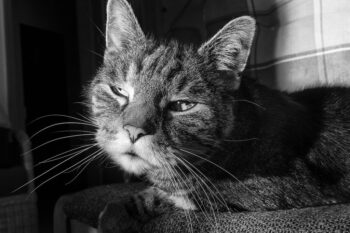
Timely article as we had to put down my cat, Jazzy, yesterday. (age 13) I could not wait through all the processes you describe as she had bladder cancer and with peeing blood, steady weight loss and her decision to stop eating and drinking, after 3 days we made the decision that it was time. I measured quality of life and chose to act before it became the extremes you menioned. A personal decision each caregiver must make, but the heartbreak is the same whenever the choice is made.
It is so hard on cat parents when that time comes. My Pogo, who is 16 1/2, also has cancer, and his life right now is measured in days. He, too, is barely eating, and I don’t want him to suffer unnecessarily. He has lost so much weight; looks scruffy because he has quit grooming, and spends most of his time lying in a warm place. You are right — it is a very hard personal decision, but I’m afraid I must send him over the Rainbow Bridge. It’s heart-breaking.